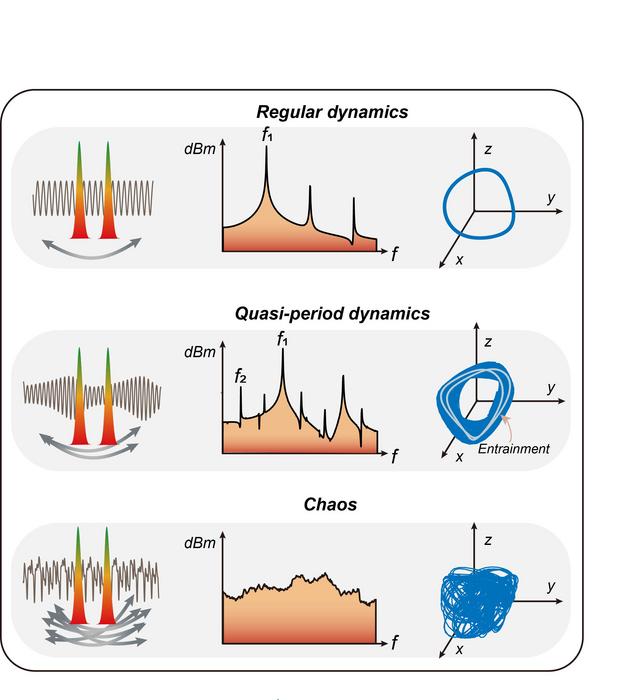A team of researchers led by Minglie Hu, and their colleagues from institutions including Tianjin University and the Southern University of Science and Technology, have made significant advancements in understanding the complex dynamics of soliton molecules in optical resonators. Their research, titled “Quasi-Period Dynamics of Soliton Molecules: Route to Chaos and Intrinsic Frequency Entrainment,” offers new insights into the quasi-periodic behaviors and chaotic transitions of soliton molecules, presenting new opportunities for applications in optical communication and other fields.

Credit: Ultrafast Science
A team of researchers led by Minglie Hu, and their colleagues from institutions including Tianjin University and the Southern University of Science and Technology, have made significant advancements in understanding the complex dynamics of soliton molecules in optical resonators. Their research, titled “Quasi-Period Dynamics of Soliton Molecules: Route to Chaos and Intrinsic Frequency Entrainment,” offers new insights into the quasi-periodic behaviors and chaotic transitions of soliton molecules, presenting new opportunities for applications in optical communication and other fields.
The Fascinating World of Solitons and soliton molecules
Solitons, self-reinforcing solitary waves, have been a topic of immense interest since their theoretical prediction and subsequent observation in optical fibers. Over the past fifty years, solitons have revolutionized fields such as optical communications and ultrafast laser technology. These waves, unlike regular waves that disperse and diminish over time, maintain their shape and energy over long distances due to a precise balance of nonlinearity and dispersion.
Soliton molecules, akin to matter molecules, exhibit complex internal dynamics due to the balance of attractive and repulsive forces between adjacent pulses in a mode-locked fiber laser. These molecules are formed under specific conditions in optical fibers, where individual solitons become bound together, creating a stable, composite structure. The dynamics of soliton molecules are rich and varied, involving interactions that can lead to pulsations, oscillations, and even chaotic behavior.
Unveiling the Quasi-Periodic Dynamics of Soliton Molecules
The study employs advanced balanced optical cross-correlation (BOC) techniques to characterize the quasi-periodic dynamics of soliton molecules. The team observed that these dynamics are constituted by cascaded Hopf bifurcations, which provide a clear pathway towards chaotic soliton molecules. This transition from order to chaos is meticulously analyzed using various methods, including time series, radio frequency (RF) spectra, phase portraits, and Lyapunov exponent analysis.
The experimental setup involved generating pulsating soliton molecules by varying the pump strength in a mode-locked fiber laser. The team utilized the BOC method to capture real-time intramolecular dynamics, overcoming the limitations of conventional probing devices. Their findings indicate that the internal motion of soliton molecules, observed at different pump strengths, exhibits distinct quasi-periodic oscillations that transition into chaos as the pump strength increases. The researchers provided strong evidence of the rapid changes in internal dynamics through the modulation depth of spectral interference fringes and the appearance of additional peaks in the RF spectrum. These observations confirm the chaotic behavior within the soliton molecules, characterized by unpredictable and aperiodic oscillations.
Discovering Intrinsic Frequency Entrainment
One of the most remarkable discoveries of this study is the intrinsic frequency entrainment phenomenon observed experimentally. Frequency entrainment refers to the synchronization of multiple oscillations, a phenomenon seen in various natural and engineered systems. In the context of soliton molecules, this frequency entrainment showcases a novel perspective on synchronization within optical resonators, encompassing interactions across multiple temporal scales.
The discovery of intrinsic frequency entrainment in soliton molecules has profound theoretical and practical implications. Theoretically, it provides a deeper understanding of synchronization phenomena in nonlinear systems. Synchronization is a universal concept observed in many natural and engineered systems, from the coordinated flashing of fireflies to the synchronous operation of power grids. Observing this phenomenon in soliton molecules adds to the growing body of knowledge on how complex systems achieve and maintain synchronized states. Dr. Penglai Guo, a distinguished researcher in fiber lasers in Macau University of Science and Technology, provides a compelling analysis of the study’s significance: “The discovery of intrinsic frequency entrainment in soliton molecules represents a leap in understanding of complex optical systems”.
Conclusion
This study by Defeng Zou et al. marks a compelling achievement in the exploration of soliton molecules, providing a comprehensive analysis of their quasi-periodic dynamics and the route to chaos. The discovery of intrinsic frequency entrainment adds a new dimension to understanding of synchronization in optical resonators. As the field of nonlinear dynamics continues to evolve, these findings will pave the way for future research into the intricate behaviors of solitons and their potential applications in various technological domains.
Journal
Ultrafast Science
DOI
10.34133/ultrafastscience.0061
Method of Research
Experimental study
Subject of Research
Not applicable
Article Title
Quasi-Period Dynamics of Soliton Molecules: Route to Chaos and Intrinsic Frequency Entrainment
Article Publication Date
21-May-2024




